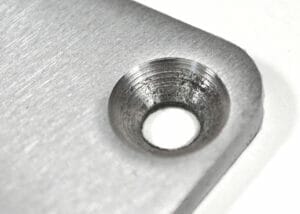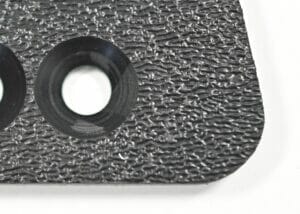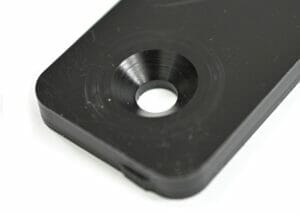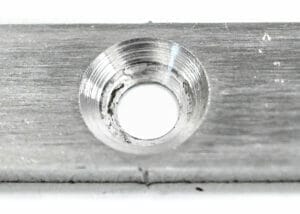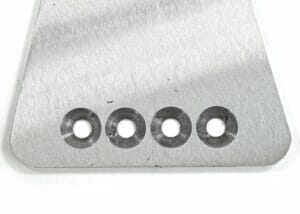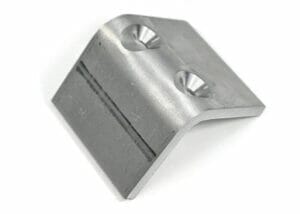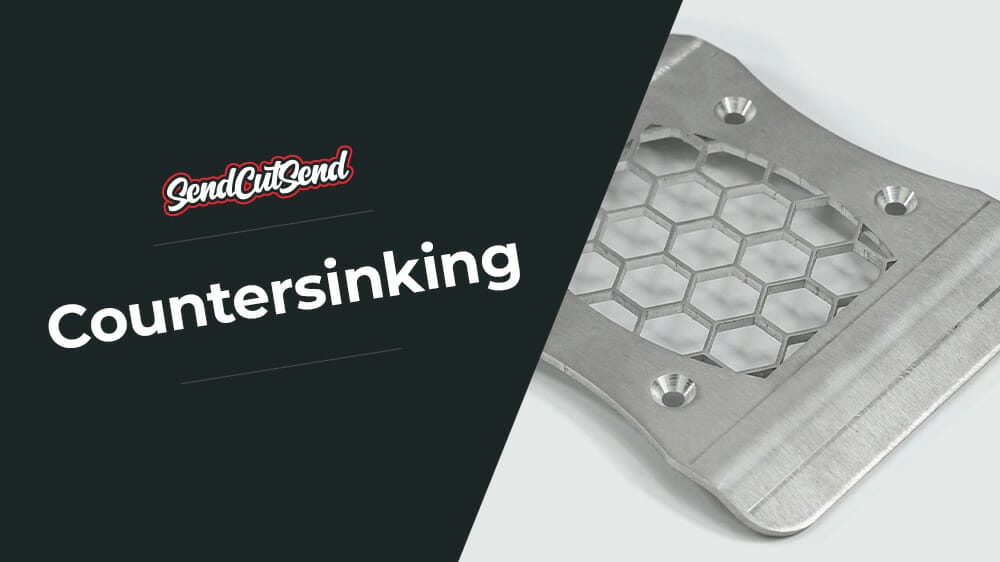
Get parts as low as $0.67 per hole with bulk pricing. Save up to 70% with quantity discounts! We calculate quantity discounts based on several factors including material, operation type, number of operations on each part and number of duplicate parts. Our app will automatically provide quantity discounts based on your order.
The success of countersinking is heavily dependent upon the material thickness and the size of the part, so we’ve implemented sizing minimums and maximums your part will need to adhere to in order to be countersunk:
Minimum part size of 1” x 4”
Maximum part size of 14” x 46”
Be sure to check our Processing Min/Max chart for more information on minimum and maximum geometry for your specific material, thickness, and part size.
At this time, we offer 7 materials for countersinking:
When you upload your file to our app, you’ll be able to view your part in a 3D model to check that the final product will function the way you intended. Use this model to make sure your countersinks are placed in the correct orientation on your part. Countersinks can be drilled from the top or bottom face of a part, so it’s important to check carefully that the desired direction for each countersink is indicated on the correct face. You can change countersink direction by clicking the up or down arrow by the countersink size you’ve chosen for each hole.

When setting up your file for countersinking, keep in mind that you only need to include the inner circumference of the hole (called the Minor) that is to be countersunk. Do not include the outer circumference (the size of the countersink, called the Major) in your file as that is what will be cut during the machining process, causing your hole to be too large to countersink. Your file should look like the one indicated here:
The Major hole size should be the same size or slightly larger than the diameter of the hardware head you’re using. It’s best to use the exact diameter of the hardware head as your reference, but a good rule of thumb is to make the countersink 50% larger than the internal hole (Minor).
When selecting your hole operations for the desired hole in your design, we will automatically resize the hole to the required size as long as the starting hole is less than 4.00” in diameter. Please keep in mind that because they will resize, you will need to verify you have adequate clearance to other features and edges of the material.
You can see examples of countersinking sizing in the chart below. It’s important to note that these examples are based on sample hardware (linked in the chart) and hardware specifications and styles will vary based on the manufacturer.
| Hardware Size | Hardware Head Diameter | Countersink Minor Diameter | Countersink Major Diameter | Countersink Depth |
|---|---|---|---|---|
| 10-32, ⅜” Hex Drive Flat Head Screws | 0.411” | 0.194” | 0.411” | 0.127” |
| ¼-20, ⅜” Hex Drive Flat Head Screws | 0.531” | 0.250” | 0.531” | 0.161” |
| Hardware Size | Hardware Head Diameter | Countersink Minor Diameter | Countersink Major Diameter | Countersink Depth |
|---|---|---|---|---|
| M5 x .8mm, 14mm Hex Drive Flat Head Screw | 10mm | 5mm | 10mm | 2.8mm |
| M8 x 1.25mm, 12mm Hex Drive Flat Head Screw | 16mm | 8mm | 16mm | 4.4mm |
The depth of the countersink should be no more than 60% of the material thickness. Any deeper and you are risking the structural integrity of the material and part. If your countersink needs to exceed that depth, make sure the holes are spaced out far enough away from each other to prevent undue stress. Here, depth is defined as the distance from the surface of the material or top of the cone to the bottom of the cone. This is typically considered the head height for flat head bolt hardware specifications.
The angle of the countersink is dependent upon the hardware being used. Ideally, the hardware has at least 50% contact with the countersunk hole, but it doesn’t have to match exactly. The standard countersink angle for metric hardware is 90°, and the standard countersink angle for imperial hardware is 82°. We offer sizes in both angles.
The “Major” measurement shown here is the larger diameter at the top of the countersink, and the “Minor” measurement is the smaller diameter at the bottom of the countersink where the hole is at its smallest
When selecting your hole operations for the desired hole in your design, we will automatically resize the hole to the required size as long as the starting hole is less than 4.00” in diameter.
Please keep in mind that because they will resize, you will need to verify you have adequate clearance to other features and edges of the material.
| Metric Flat Head Bolt | Major | Minor | Depth |
|---|---|---|---|
| M2 x 0.4mm | 4mm (0.157”) | 2.39mm (0.099”) | .074mm (.029″) |
| M2.5 x 0.45mm | 5mm (0.197”) | 2.49mm (0.103”) | 1.19mm (.047″) |
| M3 x 0.5mm | 6mm (0.236”) | 3.18mm (0.130”) | 1.35mm (.053″) |
| M4 x 0.7mm | 8mm (0.315”) | 4.04mm (0.164”) | 1.93mm (.076″) |
| M5 x 0.8mm | 10mm (0.394”) | 5.00mm (0.202”) | 2.44mm (.096″) |
| M6 x 1mm | 12mm (0.472”) | 6.35mm (0.255”) | 2.77mm (.109″) |
| M8 x 1.25mm | 16mm (0.630”) | 8.00mm (0.320”) | 3.94mm (.155″) |
| Standard Flat Head Bolt | Major | Minor | Depth |
|---|---|---|---|
| 4-40 | 0.255” (6.48mm) | 0.130” (3.18mm) | .072″ (1.83mm) |
| 6-32 | 0.307” (7.80mm) | 0.164” (4.04mm) | .082″ (2.08mm) |
| 8-32 | 0.359” (9.12mm) | 0.193” (4.78mm) | .095″ (2.41mm) |
| 10-24 | 0.411” (10.44mm) | 0.199” (4.93mm) | .122″ (3.10mm) |
| 10-32 | 0.411” (10.44mm) | 0.199” (4.93mm) | .122″ (3.10mm) |
| 1/4-20 | 0.531” (13.49mm) | 0.255” (6.35mm) | .159″ (4.04mm) |
| 1/4-28 | 0.531” (13.49mm) | 0.255” (6.35mm) | .159″ (4.04mm) |
| 5/16-18 | 0.656” (16.66mm) | 0.318” (8.08mm) | .194″ (4.93mm) |
| 5/16-24 | 0.656” (16.66mm) | 0.318” (8.08mm) | .194″ (4.93mm) |
More details are available from our preferred vendor, McMaster
